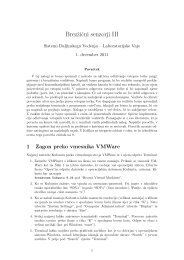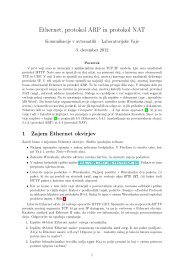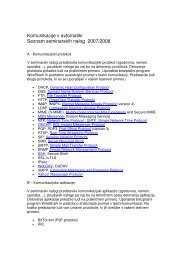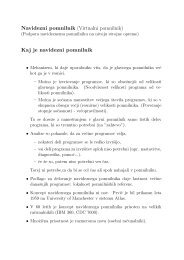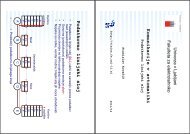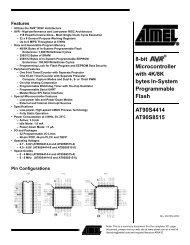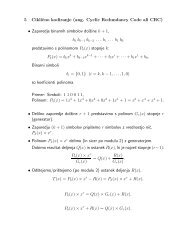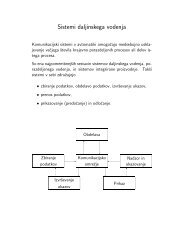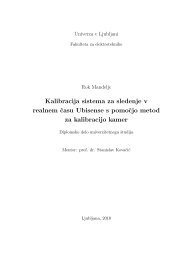A Template-Based Multi-Player Action Recognition of the Basketball ...
A Template-Based Multi-Player Action Recognition of the Basketball ...
A Template-Based Multi-Player Action Recognition of the Basketball ...
You also want an ePaper? Increase the reach of your titles
YUMPU automatically turns print PDFs into web optimized ePapers that Google loves.
CVBASE '06 - Proceedings <strong>of</strong> ECCV Workshop on Computer Vision<br />
<strong>Based</strong> Analysis in Sport Environments, Graz, Austria, May 12th, 2006, pp. 71-82<br />
A<strong>Template</strong>-<strong>Based</strong> <strong>Multi</strong>-<strong>Player</strong> <strong>Action</strong><br />
<strong>Recognition</strong> <strong>of</strong> <strong>the</strong> <strong>Basketball</strong> Game<br />
Matej Perˇse, Matej Kristan, Janez Perˇs, and Stanislav Kovačič<br />
University <strong>of</strong> Ljubljana, Faculty <strong>of</strong> Electrical Engineering<br />
Trˇzaska 25, 1000 Ljubljana, Slovenia<br />
{matej.perse, matej.kristan, janez.pers, stanislav.kovacic}@fe.uni-lj.si<br />
http://vision.uni-lj.si<br />
Abstract. In this paper we present a method for fully automatic trajectory<br />
based analysis <strong>of</strong> basketball game in <strong>the</strong> form <strong>of</strong> large and small<br />
scale modelling <strong>of</strong> <strong>the</strong> game. The large-scale game model is obtained<br />
by dividing <strong>the</strong> game into several game phases. Every game phase is<br />
<strong>the</strong>n individually modelled using mixture <strong>of</strong> Gaussian distributions. The<br />
Expectation-Maximization algorithm is used to determine <strong>the</strong> parameters<br />
<strong>of</strong> <strong>the</strong> Gaussian distributions. On <strong>the</strong> o<strong>the</strong>r hand, <strong>the</strong> small-scale<br />
modelling <strong>of</strong> <strong>the</strong> game deals with specific basketball actions which can<br />
be defined in <strong>the</strong> form <strong>of</strong> action templates that are used by <strong>the</strong> basketball<br />
experts to pass <strong>the</strong>ir instructions to <strong>the</strong> players. For <strong>the</strong> recognition purposes<br />
we define <strong>the</strong> basic game elements which are <strong>the</strong> building blocks<br />
<strong>of</strong> <strong>the</strong> more complex game actions. These elements are <strong>the</strong>n used to semantically<br />
describe <strong>the</strong> observed basketball actions and <strong>the</strong> templates.<br />
To establish if <strong>the</strong> observed action corresponds to <strong>the</strong> template, <strong>the</strong> similarity<br />
<strong>of</strong> descriptions is calculated using Levenstein distance measure.<br />
Experiments show that <strong>the</strong> proposed method could become a powerful<br />
tool for <strong>the</strong> recognition <strong>of</strong> various basketball actions.<br />
1 Introduction<br />
Every coach’s goal is to be in possession <strong>of</strong> information that could give him a<br />
tactical advantage over his opponents. This is <strong>the</strong> reason for increasing volume<br />
<strong>of</strong> research concentrated on <strong>the</strong> problem <strong>of</strong> automatic or semi-automatic game<br />
analysis using different sources <strong>of</strong> data, e.g. using statistical data produced during<br />
<strong>the</strong> game [1],ormanually labelled events from game videos [2]. Even though<br />
<strong>the</strong>se methods proved to be very successful in discovering different complex interactions<br />
which are sometimes hidden even to <strong>the</strong> eye <strong>of</strong> experienced coach [2],<br />
<strong>the</strong>y all had a crucial deficiency <strong>of</strong> tedious manual event detection and labelling.<br />
Labelling usually has to be done by one or more sport experts - not only very<br />
time consuming and potentially very expensive task. This has motivated our<br />
work towards a system, which would be able to automatically recognize and<br />
evaluate team behavior from <strong>the</strong> player trajectories obtained by <strong>the</strong> means <strong>of</strong><br />
computer vision based tracking algorithms [3], see Fig. 1.<br />
For this purpose, we decided to build a game model on two scales - a large<br />
and a small scale. The main purpose <strong>of</strong> <strong>the</strong> large-scale model is to segment <strong>the</strong><br />
71
<strong>Player</strong> Tracking<br />
Module<br />
Trajectory<br />
Database<br />
Temporal<br />
Game<br />
Segmentation<br />
<strong>Action</strong><br />
evaluation<br />
Analysis Module<br />
Play Designer<br />
Module<br />
Play Book<br />
Semantic<br />
Description <strong>of</strong><br />
<strong>the</strong> game.<br />
Description<br />
String<br />
Matching<br />
Game Specific Knowledge<br />
- Court model<br />
- Starting formation detection<br />
- Screens detection<br />
- <strong>Player</strong> motion detection<br />
- User annotations<br />
Fig. 1. System configuration and game processing pipeline.<br />
game into several phases (e.g. <strong>of</strong>fense, defense). This is important for small-scale<br />
game recognition, since <strong>the</strong>re is a fundamental difference between analyzing for<br />
example <strong>the</strong> <strong>of</strong>fensive phase or <strong>the</strong> defensive phase <strong>of</strong> <strong>the</strong> game.<br />
In this work we present <strong>the</strong> recognition <strong>of</strong> small-scale events in <strong>the</strong> <strong>of</strong>fensive<br />
phase <strong>of</strong> <strong>the</strong> game. We adopt <strong>the</strong> concept <strong>of</strong> event recognition in <strong>the</strong> form <strong>of</strong><br />
action templates, which can be interactively defined by <strong>the</strong> game expert (Fig. 2).<br />
Fig. 2. Example <strong>of</strong> a ”Flex” action template designed with Play designer module (see<br />
Fig 1).<br />
We developed a special tool - <strong>the</strong> Play Designer module, that allows us to enter<br />
<strong>the</strong> spatial (<strong>the</strong> position on <strong>the</strong> court) and temporal (<strong>the</strong> duration and order <strong>of</strong><br />
<strong>the</strong> events) properties <strong>of</strong> <strong>the</strong> basic events that are <strong>the</strong> building blocks <strong>of</strong> a more<br />
complex structure which is called an (<strong>of</strong>fensive) action. Once <strong>the</strong> properties <strong>of</strong><br />
<strong>the</strong>se events are determined <strong>the</strong>y are stored in <strong>the</strong> action database (playbook).<br />
The reason for using this approach is that <strong>the</strong> game experts usually do not<br />
possess <strong>the</strong> engineering knowledge, but are already used to design and to communicate<br />
<strong>the</strong>ir knowledge in <strong>the</strong> form <strong>of</strong> templates such as <strong>the</strong> one shown in Fig.<br />
2.<br />
This paper is structured as follows. In Section 2 <strong>the</strong> modelling and recognition<br />
<strong>of</strong> <strong>the</strong> large-scale basketball game is presented. Then, we present <strong>the</strong> detectors<br />
72
<strong>of</strong> <strong>the</strong> basic basketball elements and describe how <strong>the</strong>se detectors can be used to<br />
semantically describe <strong>the</strong> <strong>of</strong>fensive phase <strong>of</strong> <strong>the</strong> game and use <strong>the</strong>se descriptions<br />
to recognize <strong>the</strong> more complex actions. In Section 4 we present <strong>the</strong> experimental<br />
results <strong>of</strong> our method. Finally, we discuss <strong>the</strong> advantages and disadvantages <strong>of</strong><br />
<strong>the</strong> proposed game analysis approach.<br />
2 Modelling <strong>the</strong> large-scale team behavior<br />
Although different sports have very different rules and <strong>the</strong> goals <strong>of</strong> <strong>the</strong> game are<br />
diverse, <strong>the</strong>re are some common large-scale properties, which can be observed in<br />
almost any type <strong>of</strong> a multi-player sport game. Many sport games can be regarded<br />
as a process consisting <strong>of</strong> some number <strong>of</strong> discrete phases such as <strong>of</strong>fensive game,<br />
defensive game, time outs, inactive game, etc. We decided to build <strong>the</strong> game<br />
model consisting <strong>of</strong> three game phases: <strong>of</strong>fensive game (m1), defensive game<br />
(m2) andtime outs(m3):<br />
M =[m1,m2,m3] T ; (i =1, 2, 3) . (1)<br />
The probabilistic phase model was defined as a mixture <strong>of</strong> Gaussian model:<br />
p(x|mi) =<br />
n<br />
αip(x|μi,Σi) , (2)<br />
i=1<br />
where parameters αi represent mixing coefficients such that n<br />
αi =1,and<strong>the</strong><br />
i=1<br />
multivariate Gaussian density function is defined as<br />
p(x|μ, Σ) =<br />
1<br />
(2π) d/2 1<br />
e− 2<br />
|Σ| 1/2 (x−μ)T Σ −1 (x−μ)<br />
. (3)<br />
We base our phase models solely on <strong>the</strong> observation <strong>of</strong> player positions and <strong>the</strong>ir<br />
movement. Similar to <strong>the</strong> work <strong>of</strong> Erdmann [4], we model <strong>the</strong> game phases simply<br />
by observing <strong>the</strong> team gravity center. Therefore <strong>the</strong> state vector x is<br />
x =[xt,yt,δxt,δyt] T , (4)<br />
where xt and yt represent <strong>the</strong> position <strong>of</strong> <strong>the</strong> team gravity center and δxt and<br />
δyt represent <strong>the</strong> velocity <strong>of</strong> <strong>the</strong> gravity center at time t:<br />
xt = 1<br />
m<br />
m<br />
i=1<br />
xi , yt = 1<br />
m<br />
m<br />
yi , (5)<br />
where m stands for <strong>the</strong> number <strong>of</strong> active players on <strong>the</strong> court.<br />
To determine <strong>the</strong> number <strong>of</strong> Gaussian distributions used in <strong>the</strong> phase model<br />
and <strong>the</strong>ir parameters we use <strong>the</strong> Expectation Maximization (EM) algorithm [5]<br />
on manually labelled sequences. The labelling <strong>of</strong> every sample into one <strong>of</strong> <strong>the</strong><br />
three phases was done by using <strong>the</strong> expert knowledge.<br />
73<br />
i=1
a) b)<br />
Fig. 3. (a) Labelling <strong>of</strong> sequences into one <strong>of</strong> <strong>the</strong> three phases. (b) Likelihood functions<br />
<strong>of</strong> <strong>the</strong> probabilistic game phase models obtained with EM algorithm (p(x|m1) - full<br />
line, p(x|m2) - dashed line, p(x|m3) - dotted line). The arrows show <strong>the</strong> direction and<br />
size <strong>of</strong> velocity component in <strong>the</strong> state vector.<br />
Once <strong>the</strong> model <strong>of</strong> <strong>the</strong> game is built, we can classify a given sample at time t<br />
into one <strong>of</strong> <strong>the</strong> three game phases simply by determining <strong>the</strong> highest a posteriori<br />
probability using Bayes formula:<br />
m∗(t) =max<br />
i∈M (p(mi|x(t)))<br />
<br />
p(x(t)|mi)p(mi)<br />
= max<br />
∝ p(x(t)|mi)p(mi) , (6)<br />
i∈M p(x(t))<br />
where p(mi) is<strong>the</strong>aprioriprobability that sample x belongs to <strong>the</strong> phase mi.<br />
These probabilities were set in advance using expert knowledge,<br />
p(M) = 0.45, 0.45, 0.10 T . (7)<br />
Since <strong>the</strong> analysis is an <strong>of</strong>f-line process, <strong>the</strong> information <strong>of</strong> past and future<br />
samples can be used. Therefore, once all <strong>the</strong> samples are individually labelled<br />
into one <strong>of</strong> <strong>the</strong> three categories, a nonlinear filter is used to incorporate <strong>the</strong> time<br />
continuity <strong>of</strong> <strong>the</strong> game into<strong>the</strong>model.Thisway,<strong>the</strong>t-th sample is assigned<br />
<strong>the</strong> phase label that receives <strong>the</strong> highest score among all <strong>the</strong> phases inside <strong>the</strong><br />
observed filter window <strong>of</strong> length N,<br />
⎧<br />
⎫<br />
⎨ t+N/2 ⎬ <br />
1; m∗(k) =mi<br />
m∗∗(t) =max D(k) , D(k) =<br />
. (8)<br />
i∈M ⎩<br />
⎭ 0; m∗(k) = mi<br />
k=t−N/2<br />
The filter window should not be too wide, but should be wide enough to cover <strong>the</strong><br />
shortest possible phase length. This way we reduce <strong>the</strong> unwanted effect <strong>of</strong> rapid<br />
model switching produced by not taking into account <strong>the</strong> neighboring samples<br />
and at <strong>the</strong> same time we preserve <strong>the</strong> phase boundaries.<br />
3 Definition and detection <strong>of</strong> small-scale team behavior<br />
Once <strong>the</strong> large-scale segmentation <strong>of</strong> <strong>the</strong> game iscompleted <strong>the</strong> analysis <strong>of</strong> smallscale<br />
team behavior can take place.<br />
74
At this scale <strong>of</strong> <strong>the</strong> game, <strong>the</strong> specific game elements can be observed. These<br />
elements vary significantly from sport to sport and depend on <strong>the</strong> game rules<br />
and <strong>the</strong> ultimate goal <strong>of</strong> <strong>the</strong> team. Forexample in <strong>the</strong> <strong>of</strong>fensive part <strong>of</strong> <strong>the</strong><br />
basketball or handball game <strong>the</strong>re are typical situations where a player tries to<br />
make <strong>the</strong> space for his teammate by blocking his teammate’s defender and by<br />
doing so giving him a better chance to fulfill a given task. This element is called<br />
screening. Ano<strong>the</strong>r example (cutting) can be observed in basketball or soccer,<br />
where players try to cut <strong>the</strong>ir way into <strong>the</strong> empty space on <strong>the</strong> court where <strong>the</strong>y<br />
have a better chance <strong>of</strong> receiving <strong>the</strong> ball and scoring.<br />
The sequences <strong>of</strong> such events define a play. Plays are trained in advance<br />
and can only be successful if all <strong>the</strong> players as a team are performing well. The<br />
sports experts call this ”team tactics” and can be defined as <strong>the</strong> coordinated<br />
player activity aiming to achieve <strong>the</strong> given task. Although <strong>the</strong> team action can<br />
adapt according to <strong>the</strong> actual situation on <strong>the</strong> court, <strong>the</strong> general concept <strong>of</strong><br />
<strong>the</strong> team tactics always remains <strong>the</strong> same. As it will be shown, it is possible<br />
to recognize <strong>the</strong> predefined team actions just by observing <strong>the</strong> sequence <strong>of</strong> <strong>the</strong><br />
basic game elements.<br />
For <strong>the</strong> purpose <strong>of</strong> small-scale action recognition <strong>the</strong> game-specific semantic<br />
description <strong>of</strong> <strong>the</strong> activities during <strong>the</strong> observed period <strong>of</strong> time was implemented.<br />
There are several reasons for selecting this approach:<br />
– The influence <strong>of</strong> temporal variability <strong>of</strong> observed action and its elements is<br />
reduced since only <strong>the</strong> information about <strong>the</strong> order <strong>of</strong> <strong>the</strong> events is retained.<br />
– There is no need <strong>of</strong> reanalyzing <strong>the</strong> trajectories when a new action definition<br />
is added to <strong>the</strong> database <strong>of</strong> templates (playbook) and thus significantly<br />
reducing <strong>the</strong> analysis time.<br />
– Different players can play different roles in actions <strong>of</strong> <strong>the</strong> same type.That<br />
is why players have to be ”casted” into <strong>the</strong>ir respective roles during <strong>the</strong><br />
recognition process.<br />
– The same approach can be used to compare semantic description <strong>of</strong> two<br />
different actions.<br />
3.1 Game specific knowledge<br />
Since we are dealing only with players trajectories and have no knowledge about<br />
possession <strong>of</strong> <strong>the</strong> ball, we turn our attention to <strong>the</strong> recognition <strong>of</strong> trajectorybased<br />
game elements. The main information that can be extracted this way is<br />
<strong>the</strong> types <strong>of</strong> <strong>the</strong> basic elements which compose <strong>the</strong> more complex action and <strong>the</strong><br />
locations <strong>of</strong> <strong>the</strong>ir occurrences on <strong>the</strong> court. That is, player X movement (M) into<br />
some court region A can be described as<br />
<strong>Player</strong>X M CourtRegionA.<br />
For this purpose we need to define <strong>the</strong>se game specific elements and build a<br />
model <strong>of</strong> <strong>the</strong> court to limit <strong>the</strong> possible number <strong>of</strong> regions.<br />
75
Court modelling<br />
Studying different sources <strong>of</strong> basketball literature and consulting several experts<br />
about <strong>the</strong> possible court division, we did not come across any consistent<br />
information about <strong>the</strong> type <strong>of</strong> <strong>the</strong> court model or any o<strong>the</strong>r kind <strong>of</strong> court parcelling.<br />
The main reason for this is that couches usually describe <strong>the</strong> game in<br />
<strong>the</strong> form <strong>of</strong> playing positions (eg. point guard, forward or center), which do not<br />
have deterministic edges such as our court regions should have had. This is why<br />
we decided to build our own model which would, as precisely as possible reflect<br />
<strong>the</strong> actual playing regions.<br />
To build <strong>the</strong> court model we used 2x17 (left and right version) different<br />
definitions <strong>of</strong> <strong>of</strong>fensive actions - action templates [6]. For every single action<br />
template, <strong>the</strong> positions <strong>of</strong> <strong>the</strong> basic events were observed and <strong>the</strong>n used to divide<br />
<strong>the</strong> court into some number <strong>of</strong> non-overlapping playing areas using <strong>the</strong> k-means<br />
clustering algorithm. Fig. 4(a) shows <strong>the</strong> extracted points and court regions,<br />
nine in this case.<br />
RIGHT_<br />
CORNER<br />
RIGHT_WING<br />
RIGHT_<br />
POST<br />
KEY<br />
LEFT_<br />
POST<br />
PIVOT<br />
LEFT_<br />
CORNER<br />
TOP_KEY<br />
LEFT_WING<br />
aa) ab)<br />
Fig. 4. (a) The right side <strong>of</strong> <strong>the</strong> court shows <strong>the</strong> points extracted from <strong>the</strong> 34 action<br />
definitions. The left side shows <strong>the</strong> names <strong>of</strong> <strong>the</strong> regions obtained using k-means clustering<br />
algorithm. (b)Actual trajectories <strong>of</strong> ”Flex” <strong>of</strong>fense. Red circles denote players’<br />
starting positions.<br />
Definition <strong>of</strong> basic events<br />
Coupling <strong>the</strong> control <strong>the</strong>ory with <strong>the</strong> knowledge <strong>of</strong> <strong>the</strong> basketball expert,<br />
we define a sport game as a sequence <strong>of</strong> events. In <strong>the</strong> basketball <strong>of</strong>fense <strong>the</strong>se<br />
events are: team starting formation, screening, player motion on <strong>the</strong> court, and<br />
ball passing. Since we have no information about <strong>the</strong> ball we only observe <strong>the</strong><br />
first three elements.<br />
76<br />
05<br />
04<br />
01<br />
02<br />
03
–Team starting formation is <strong>the</strong> most distinctive indicator that an <strong>of</strong>fensive<br />
action has been initiated. The probability that <strong>the</strong> formation has been<br />
observed can be defined as a sum <strong>of</strong> a product <strong>of</strong> Gaussian distributions over<br />
all players on <strong>the</strong> court, normalized with <strong>the</strong> factor <strong>of</strong> all players standing<br />
at <strong>the</strong>ir optimal positions defined by <strong>the</strong> playbook<br />
pformation =<br />
n<br />
N(ri,σr) · N(di,σd)<br />
n<br />
N(ri,σr) · N(0,σd)<br />
, (9)<br />
i=1<br />
i=1<br />
where ri is <strong>the</strong> players current distance from <strong>the</strong> basket and di is <strong>the</strong> distance<br />
from his optimal position in Euclidean terms<br />
r = (x − xbasket) 2 +(y − ybasket) 2 , (10)<br />
d =<br />
<br />
(x − xref) 2 +(y − yref) 2 . (11)<br />
This definition <strong>of</strong> <strong>the</strong> formation detector is particularly suitable as it takes<br />
into account that players which are fur<strong>the</strong>r from <strong>the</strong> basket do not have as<br />
many points <strong>of</strong> orientation such as free throw line, and as a consequence <strong>the</strong>y<br />
tend to position <strong>the</strong>mselves fur<strong>the</strong>r from <strong>the</strong>ir optimal position.<br />
– A screen is defined as a close contact <strong>of</strong> two players [6] where <strong>the</strong> player who<br />
is making <strong>the</strong> screen stands as still as possible and <strong>the</strong> player who is taking<br />
<strong>the</strong> screen runs close nearby <strong>the</strong> first player. This way a screen probability<br />
can be calculated as<br />
pscreen = N(d, σd) · N(vmin,σv) . (12)<br />
Here <strong>the</strong> variable d defines <strong>the</strong> distance between <strong>the</strong> two players and vmin<br />
defines <strong>the</strong> velocity <strong>of</strong> <strong>the</strong> slowest player.<br />
– The court model described in <strong>the</strong> beginning <strong>of</strong> this section is used to quantize<br />
and semantically describe <strong>the</strong> payer motionon<strong>the</strong>court. The court<br />
model was designed to account for <strong>the</strong> variability in player’s movement relative<br />
to <strong>the</strong> ideal path in <strong>the</strong> way that <strong>the</strong> variability inside <strong>the</strong> region is<br />
not important for <strong>the</strong> player’s performance. Using this model it is possible<br />
to describe <strong>the</strong> player’s motion simply be observing <strong>the</strong> regions <strong>of</strong> <strong>the</strong> court<br />
<strong>the</strong> player has covered.<br />
Using <strong>the</strong> above definitions we can obtain <strong>the</strong> following semantic description<br />
(Table 1) <strong>of</strong> trajectories from Fig. 4(b).<br />
77
Table 1. Initial part <strong>of</strong> semantic description <strong>of</strong> trajectories from Fig. 4.The numbers<br />
denote <strong>the</strong> occurrence order.<br />
(1) P1 M RIGHT POST, (7) FORM flex1, (12) P4 M LEFT POST,<br />
(2) P2 M LEFT POST, (8) P3 M LEFT POST, (13) SCR 2 4 LEFT POST,<br />
(3) P3 M LEFT CORNER, (9) SCR 2 3 LEFT POST, (14) FORM flex1 inv,<br />
(4) P4 M LEFT WING, (10) P1 M RIGHT CORNER, (15) P2 M LEFT WING,<br />
(5) P5 M RIGHT WING, (11) P3 M KEY, (16) SCR 2 3 LEFT POST ...<br />
3.2 <strong>Action</strong> recognition using action templates<br />
The main goal <strong>of</strong> action recognition with templates is to establish <strong>the</strong> correspondence<br />
between <strong>the</strong> observed action and <strong>the</strong> predetermined action template, such<br />
as <strong>the</strong> one from Fig. 2.<br />
On <strong>the</strong> contrary to <strong>the</strong> work <strong>of</strong> Intille and Bobick [7] or Jug et al. [8], where<br />
authors built <strong>the</strong>ir game models using belief networks and temporal graphs to<br />
represent <strong>the</strong> action models and use <strong>the</strong>se model for recognition and evaluation<br />
<strong>of</strong> multi-agent actions from noisy trajectory data, we adopted much simpler but<br />
effective way <strong>of</strong> comparing <strong>the</strong> semantic descriptions <strong>of</strong> <strong>the</strong> analyzed action and<br />
all action templates from <strong>the</strong> playbook. This way we avoid <strong>the</strong> painstaking and<br />
sometimes very subjective decision making <strong>of</strong> determining <strong>the</strong> temporal and logical<br />
relationships <strong>of</strong> every belief network [7] and <strong>the</strong>ir mutual dependencies. Since<br />
<strong>the</strong>re are usually only few or none training examples, it is impossible evaluate<br />
<strong>the</strong>se parameters from training set and as a consequence <strong>the</strong>y are subjected to<br />
<strong>the</strong> personal experience and technical knowledge <strong>of</strong> <strong>the</strong> person who designs <strong>the</strong>m.<br />
We designed our system based on <strong>the</strong> preposition that <strong>the</strong> person who will be<br />
using <strong>the</strong> system has very little or no technical background, but is able to pass<br />
his knowledge to <strong>the</strong> system in <strong>the</strong> for <strong>of</strong> game templates. By using <strong>the</strong> proposed<br />
semantic descriptions, we are able to automatize <strong>the</strong> process <strong>of</strong> quantifying and<br />
condensing <strong>the</strong> information to only those key elements that are needed for a<br />
successful recognition <strong>of</strong> <strong>the</strong> selected action.<br />
Ano<strong>the</strong>r advantage <strong>of</strong> <strong>the</strong> proposed framework in comparison to those mentioned<br />
above is that our approach considers <strong>the</strong> possible mismatching between<br />
<strong>the</strong> predetermined players roles and actual ones and assigns role labels to players<br />
automatically (not manually as in [7] from starting positions), based on <strong>the</strong><br />
observed situation on <strong>the</strong> court. These way we reduce influence <strong>of</strong> player mismatches.<br />
This is very important since we obtain <strong>the</strong> analyzed data by video<br />
tracking <strong>of</strong> multiple interacting targets [9] which may be, event though supervised<br />
by <strong>the</strong> operator, subjected to errors.<br />
3.3 Matching trajectories to action templates<br />
After <strong>the</strong> semantic descriptions are obtained, <strong>the</strong>y can be compared using different<br />
procedures, e.g. dynamic programming [10]. To do this, we first divide <strong>the</strong><br />
real trajectories and each template semantic description into five single player<br />
role descriptions called player agendas. The agendas are built by observing if<br />
a player was involved in a particular action event. For example, all players are<br />
78
involved in <strong>the</strong> starting formation, so <strong>the</strong> formation name is assigned to all<br />
agendas. The screen label is assigned only to agendas <strong>of</strong> those two players that<br />
are involved in <strong>the</strong> screen and <strong>the</strong> player motion label is assigned only to <strong>the</strong><br />
agenda that represents that player. Considering <strong>the</strong>se rules we can transform <strong>the</strong><br />
semantic description from Table 1 to <strong>the</strong> five agendas in Table 2.<br />
Table 2. Five player agendas built from <strong>the</strong> semantic description from Table 1. The<br />
number <strong>of</strong> agendas match <strong>the</strong> original player numbers.<br />
ag1 ag2 ag3<br />
(1) M RIGHT POST (1) M LEFT POST (1) M LEFT CORNER<br />
(2) FORM flex1 (2) FORM flex1 (2) FORM flex1<br />
(3) M LEFT POST (3) SCR LEFT POST (3) SCR LEFT POST<br />
(4) M RIGHT CORNER (4) SCR LEFT POST (4) M KEY<br />
(5) FORM flex1 inv ... (5) FORM flex1 inv (5) FORM flex1 inv<br />
(6) M LEFT WING (6) SCR LEFT POST ...<br />
(7) SCR LEFT POST...<br />
ag4 ag5<br />
(1) M LEFT WING (1) M RIGHT WING<br />
(2) FORM flex1 (2) FORM flex1<br />
(3) M LEFT POST (3) FORM flex1 inv...<br />
(4) SCR LEFT POST<br />
(5) FORM flex1 inv...<br />
Once <strong>the</strong> agendas are obtained it is necessary to establish <strong>the</strong> correspondence<br />
between different player agendas as defined in action template, and <strong>the</strong> agendas<br />
observed from real trajectories (casting). This is done by cross-validating <strong>the</strong><br />
five agendas from <strong>the</strong> template with those from <strong>the</strong> observed trajectories, that<br />
is calculating m! =5!=120differentpossiblematchings (Pl). In our case a<br />
simple Levenstein distance [10] is used as a similarity measure <strong>of</strong> two different<br />
agendas which is normalized with <strong>the</strong> sum <strong>of</strong> agendas lengths (l+k). The highest<br />
overall similarity (smallest Levenstein distance D(R, T )) <strong>of</strong> all real trajectories<br />
and template agendas can be calculated as<br />
D(R, T )=min{ m<br />
i=1<br />
Dl(agRi,agTj)<br />
l+k }; j = Pl(i), l =1...120; (13)<br />
where Dl(agRi,agTj) stands for <strong>the</strong> Levenstein distance between i th player<br />
agenda (agRi) andj th template agenda (agTj). The Dl(agRi,agTj) indicates<br />
how well has player i performed <strong>the</strong> elements <strong>of</strong> j th role in <strong>the</strong> template. The<br />
match D(R, T )thathas<strong>the</strong>smallest distance represents <strong>the</strong> optimal assignment<br />
<strong>of</strong> player roles to roles from <strong>the</strong> template and at <strong>the</strong> same time to shows how<br />
well is <strong>the</strong> observed action performed according to <strong>the</strong> compared action template.<br />
3.4 Assigning template label to <strong>the</strong> observed action<br />
To determine <strong>the</strong> template that is <strong>the</strong> most similar to <strong>the</strong> observed action, we<br />
first repeat <strong>the</strong> action-template matching procedure for every definition from<br />
79
<strong>the</strong> playbook database and <strong>the</strong>n calculate <strong>the</strong> average template penalty. Finally<br />
<strong>the</strong> unknown action is assigned <strong>the</strong> label <strong>of</strong> template or templates that have <strong>the</strong><br />
smallest penalty but only if <strong>the</strong>ir penalty is 10 % smaller <strong>the</strong>n <strong>the</strong> average one.<br />
This way we prevent <strong>the</strong> wrong recognition <strong>of</strong> action in cases when <strong>the</strong> observed<br />
action is not in <strong>the</strong> database. Figure 5 shows <strong>the</strong> results <strong>of</strong> matching 17 different<br />
templates to a ”Flex” <strong>of</strong>fense action.<br />
5<br />
4.5<br />
4<br />
3.5<br />
3<br />
2.5<br />
2<br />
1.5<br />
1<br />
0.5<br />
0<br />
0 2 4 6 8 10 12 14 16 18<br />
a)<br />
<strong>Player</strong>1 <strong>Player</strong>2<br />
Bb)<br />
<strong>Player</strong>3 <strong>Player</strong>4 <strong>Player</strong>5<br />
Ac)<br />
ad) ae)<br />
af)<br />
Fig. 5. (a) Results <strong>of</strong> matching ”Flex” action to 17 different templates. Green (upper)<br />
straight line shows <strong>the</strong> average penalty and red (lower) line shows <strong>the</strong> 10% boundary. (bf)<br />
Figures show <strong>the</strong> ideal player paths as defined in <strong>the</strong> ”Flex” template (black straight<br />
line) and successfully matched player trajectories <strong>of</strong> four different ”Flex” actions.<br />
4 Experimental results<br />
To test <strong>the</strong> recognition accuracy on large and small scales <strong>of</strong> <strong>the</strong> game wedesigned<br />
two separate sets <strong>of</strong> experiments. For <strong>the</strong> evaluation <strong>of</strong> large-scale recognition,<br />
we acquired about 40 minutes <strong>of</strong> real game trajectories (60700 trajectory<br />
samples). Our goal was to determine how <strong>the</strong> amount <strong>of</strong> training data and <strong>the</strong><br />
number <strong>of</strong> Gaussian models used to represent <strong>the</strong> game phases influence <strong>the</strong> final<br />
recognition result. As it can be observed in Table 3, <strong>the</strong> best classification results<br />
were obtained when <strong>the</strong> mixture <strong>of</strong> two Gaussian models was used to model<br />
each game phase (Fig. 3 b). The explanation for this is that when using more<br />
components <strong>the</strong> model tends to over-fit <strong>the</strong> training data. The two components<br />
mixture could also be explained as a model <strong>of</strong> <strong>the</strong> transition from one phase to<br />
ano<strong>the</strong>r and <strong>the</strong> model <strong>of</strong> <strong>the</strong> main behavior during that phase. We can also<br />
80
observe that <strong>the</strong>re is very small decrease in <strong>the</strong> performance results even when<br />
a relatively small percentage <strong>of</strong> data is used for training purposes.<br />
Table 3. Experimental results <strong>of</strong> game segmentation using different ratios for teaching<br />
<strong>the</strong> game model and different number <strong>of</strong> Gaussian distributions for modelling game<br />
phases with constant (five seconds) width <strong>of</strong> non-linear filtering window.<br />
The number <strong>of</strong> Gaussian models<br />
used for modelling single game phase<br />
{ m1,m2,m3 }<br />
train/test ratio [%] {1,1,1} {2,2,2} {3,3,3} {2,2,1} {3,3,2}<br />
30/70 92.5 94.0 93.4 93.3 92.4<br />
50/50 92.8 94.2 93.4 92.8 93.4<br />
100/100 92.8 94.5 95.6 92.9 94.3<br />
In our second experiment, we tested <strong>the</strong> accuracy <strong>of</strong> <strong>the</strong> proposed smallscale<br />
(action) recognition method using four different types <strong>of</strong> court models<br />
(See Table 4). Two <strong>of</strong> <strong>the</strong>m were produced using court modelling described in<br />
Section 3.1 and two <strong>of</strong> <strong>the</strong>m were produced simply by dividing <strong>the</strong> court into<br />
n identical regions (grid model). To obtain <strong>the</strong> testing sequences we asked a<br />
local basketball team to perform three different basketball <strong>of</strong>fenses 71 times.<br />
Among <strong>the</strong>se 71 <strong>of</strong>fenses 39 were played with and 32 without defensive team.<br />
The <strong>of</strong>fenses were matched to 34 (2x17) different action templates, which were<br />
obtained from various basketball literature such as [6], and by <strong>the</strong> local team<br />
coach.<br />
Table 4. Experimental results <strong>of</strong> 65 different <strong>of</strong>fensive basketball actions recognition<br />
with different types <strong>of</strong> court model. The percentages do not sum up to 100 % because<br />
some actionsmatched to two different templates.<br />
K-means model K-means model Grid model Grid model<br />
(9 regions) (16 regions) (9 regions) (18 regions)<br />
Correctly recognized 71 (100 %) 66 (92.96 %) 64 (90.14 %) 67 (94.37 %)<br />
Mislabelled 0 (0 %) 5 (7.04 %) 7 (9.86 %) 4 (5.63 %)<br />
The experiments show that <strong>the</strong>re are small variations in <strong>the</strong> recognition results<br />
when different types <strong>of</strong> court models are used. As it can be seen <strong>the</strong> k-means<br />
clustering <strong>of</strong> <strong>the</strong> court improves <strong>the</strong> recognition performance.<br />
5 Conclusion<br />
We presented a novel approach towards <strong>the</strong> automatic trajectory-based analysis<br />
<strong>of</strong> <strong>the</strong> basketball game. We demonstrated that by modelling <strong>the</strong> game just by<br />
81
<strong>the</strong> gravity center <strong>of</strong> <strong>the</strong> teams, it was possible to segment <strong>the</strong> basketball game<br />
into different game phases. Fur<strong>the</strong>rmore we showed that <strong>the</strong> best results were<br />
obtained when every game phase was modelled as a two component Gaussian<br />
mixture model. We also demonstrated that only a small amount <strong>of</strong> data was<br />
sufficient to estimate <strong>the</strong> model parameters without significantly reducing <strong>the</strong><br />
recognition rate.<br />
In <strong>the</strong> second part <strong>of</strong> <strong>the</strong> article, we presented a method for detecting specific<br />
complex basketball actions, which can be defined by <strong>the</strong> user in <strong>the</strong> form <strong>of</strong><br />
action templates. The presented results show that by comparing <strong>the</strong> semantic<br />
description <strong>of</strong> <strong>the</strong> observed trajectories and action templates it was possible to<br />
successfully match <strong>the</strong> observed trajectories to <strong>the</strong> templates. They also suggest<br />
that <strong>the</strong> recognition result are improved if <strong>the</strong> court model that maximizes <strong>the</strong><br />
possible variance <strong>of</strong> key action elements is selected. In our case this model was<br />
obtained by clustering <strong>the</strong> starting and ending positions <strong>of</strong> key action elements<br />
that have been extracted from <strong>the</strong> predetermined action templates.<br />
References<br />
1. Bhandari, I., Colet, E., Parker, J., Pines, Z., Pratap, R., Ramanujam,K.:Advanced<br />
scout: Data mining and knowledge discovery in NBA data. Data Mining and<br />
Knowledge Discovery 1 (1997)<br />
2. Borrie, A., Jonsson, G., Magnusson, M.: Temporal pattern analysis and its applicability<br />
in sport: an explanation and exemplar data. Journal <strong>of</strong> Sports Sciences 20<br />
(2002)<br />
3. Perˇse, M., Perˇs, J., Kristan, Vučkovič, M.G., Kovačič, S.: Physics-based modelling<br />
<strong>of</strong> human motion using kalman filter and collision avoidance algorithm. ISPA05<br />
(2005) 328–333<br />
4. Erdmann, W.: Ga<strong>the</strong>ring <strong>of</strong> kinematic data <strong>of</strong> sport event by televising <strong>the</strong> whole<br />
pitch and track. R. Rodano, Editor, Proceedings <strong>of</strong> 10th ISBS symposium, International<br />
Society <strong>of</strong> Biomechanics in Sports, Milan, Italy (1992) 159–162<br />
5. McLachlan, G., Krishnan, T.: The EM Algorithm and Extensions. Wiley Series<br />
in Probability and Statistics. Wiley, New York (1997)<br />
6. Kresse, J., Jablonski, R.: The Complete Book <strong>of</strong> Man-To-Man Offense. 2nd edn.<br />
Coaches Choice (2004)<br />
7. Intille, S., Bobick, A.: A framework for recognizing multi-agent action from visual<br />
evidence. In: National Conference on Artificial Intelligence (AAAI). (1999)<br />
8. Jug, M., Perˇs, J., Deˇzman, B., Kovačič, S.: Trajectory based assessment <strong>of</strong> coordinated<br />
human activity. In: Computer Vision Systems, Proceedings <strong>of</strong> Third<br />
International Conference ICVS 2003, Graz, Austria, (Lecture Notes in Computer<br />
Science, vol.2626), Springer (2003) 534–543<br />
9. Kristan, M., Perˇs, J., Perˇse, M., Bon, M., Kovačič, S.: <strong>Multi</strong>ple interacting targets<br />
tracking with application to team sports. In: 4th International Symposium on<br />
Image and Signal Processing and Analysis ISPA. (2005) 322–327<br />
10. Makinen, V., Navarro, G., Ukkonen, E.: Transposition invariant string matching.<br />
Proc. 20th International Symposium on Theoretical Aspects <strong>of</strong> Computer Science<br />
(STACS 2003), in: Lecture Notes in Comput. Sci., vol. 2607, Springer-Verlag.<br />
(2003) 191202<br />
82





